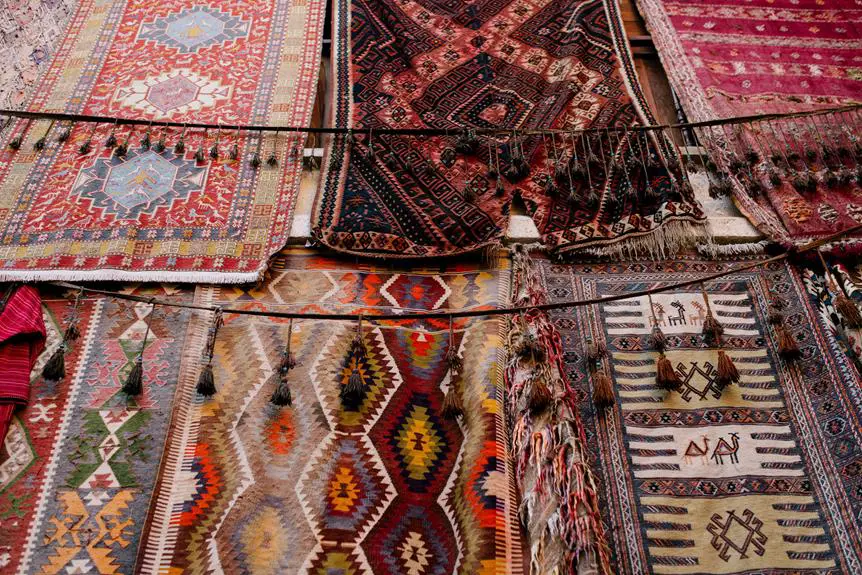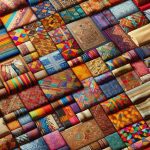Did you know that the history of flannel fabric is like a rich tapestry woven with threads of tradition and innovation?
From its humble origins as a warm and durable fabric worn by Welsh farmers to its evolution into a beloved fashion staple, flannel has a fascinating story to tell.
Its journey spans centuries and continents, revealing the enduring appeal and versatility of this timeless textile.
As you delve into the history of flannel, you'll uncover the cultural significance, technological advancements, and enduring allure that have shaped its legacy.
Get ready to explore the captivating journey of flannel fabric, from its early roots to its modern-day resurgence in fashion and home decor.
Key Takeaways
- Flannel fabric originated in Wales and was popularized by Scottish mills.
- Flannel gained popularity in the United States during the 19th century and became a symbol of the American frontier spirit and rebellion.
- Flannel transitioned from workwear to a fashion statement, loved for its comfort and versatility.
- Flannel has experienced a modern resurgence in fashion, embraced for its cozy, yet chic appeal, and can also be incorporated into home decor for warmth and coziness.
Origins of Flannel Fabric
Did you know that the origins of flannel fabric can be traced back to the 17th century in Wales? The early manufacturing of flannel began in Welsh mills, where it was initially made of carded wool or worsted yarn. However, it was the Scottish who truly popularized flannel, with its production becoming a staple of their textile industry. The word 'flannel' itself is believed to have Scottish origins, derived from the Gaelic word 'gwlan,' meaning wool.
In the early days, flannel was primarily made from either carded wool or worsted yarn, and its characteristic softness and warmth made it a favorite among those living in colder climates. Scotland's expertise in manufacturing and weaving wool made their flannel highly sought after. The fabric's popularity eventually spread to England and beyond, as its versatile nature made it suitable for various garments, from shirts to outerwear.
Understanding the Scottish origins and the early manufacturing of flannel provides insight into the fabric's rich history and enduring appeal. This background enhances your appreciation for the craftsmanship and tradition behind this beloved textile.
Early Uses and Production
The early uses and production of flannel fabric in Wales and Scotland played a crucial role in establishing its reputation for softness and warmth, making it highly sought after in colder climates. Flannel fabric has a rich history dating back to the 16th century, where it was initially made from carded wool or wool and cotton, and produced in Welsh and Scottish mills. The early production of flannel fabric was labor-intensive, with skilled artisans meticulously raising the nap of the fabric to create its characteristic soft texture. As the textile industry evolved, flannel production methods also advanced, incorporating mechanized processes to meet the growing demand for this luxurious fabric.
| Early Uses and Production | Characteristics | Emotional Response |
|---|---|---|
| Soft and Warm | Luxurious Texture | Cozy and Comforting |
| Labor-Intensive Production | Skilled Artisans | Appreciation for Craftsmanship |
| Evolution in Textile Industry | Mechanized Processes | Adaptation and Advancement |
The early production techniques and the evolution of flannel fabric in the textile industry not only shaped its quality but also contributed to its enduring appeal. This rich history adds depth to the allure of flannel fabric, making it a cherished textile with a story worth remembering.
Flannel's Popularity in the United States
Flannel fabric quickly gained popularity in the United States during the 19th century, as it was embraced for its versatility and comfort in various aspects of daily life. Its warm and soft nature made it ideal for cold weather, leading to its widespread use in clothing, especially among workers and outdoor laborers. Over time, flannel became deeply ingrained in American tradition, attaining cultural significance beyond its practical uses. The fabric's association with ruggedness and durability made it a symbol of the American frontier spirit, while its adoption into everyday fashion reflected an evolving sense of style and comfort.
As the 20th century progressed, flannel continued to be a staple in American clothing, evolving in fashion alongside societal changes. It became a symbol of rebellion and counterculture in the 1950s and 60s, often worn by musicians and activists.
Today, flannel remains an iconic part of American fashion, transcending social and economic boundaries. Its enduring popularity reflects not only its practical benefits but also its ongoing relevance in the ever-changing landscape of style and self-expression.
Flannel in Fashion History
Flannel has a rich history in the world of fashion, with its practical origins dating back to the 17th century.
From its humble beginnings as a fabric worn by farmers and laborers, flannel has experienced a modern resurgence in the fashion world.
Today, flannel is celebrated for its versatility and timeless appeal, making it a staple in many stylish wardrobes.
Flannel's Practical Origins
Digging into the practical origins of flannel in fashion history, you'll uncover its humble beginnings as a fabric worn by Welsh farmers for its warmth and durability. This textile evolution from practical uses to fashion staple is a testament to flannel's enduring appeal. Here are some key points to consider:
- Farmers' Choice: Initially, flannel was chosen by farmers due to its insulating properties, making it ideal for braving the harsh Welsh winters.
- Industrial Revolution: With the advent of the Industrial Revolution, flannel production became more efficient, leading to its widespread availability.
- Fashion Adoption: As flannel became more accessible, it transitioned from workwear to a fashion statement, eventually becoming a beloved fabric for its comfort and versatility.
Understanding flannel's practical origins provides insight into its enduring popularity and its journey from humble beginnings to a cherished fashion fabric.
Flannel's Modern Resurgence
With the resurgence of flannel in fashion history, you'll find that this fabric has seamlessly transitioned from its practical origins to a versatile and stylish wardrobe essential.
Flannel fashion has made a remarkable comeback in recent years, with designers and fashion enthusiasts embracing its cozy, yet chic appeal.
The modern resurgence of flannel textiles can be seen in a variety of clothing items, from classic flannel shirts to trendy dresses, skirts, and even accessories like scarves and hats.
The versatility of flannel allows it to be dressed up or down, making it a go-to choice for both casual and more formal looks.
Whether it's the traditional plaid patterns or solid-colored flannel pieces, this fabric has become a staple in contemporary fashion, offering comfort, warmth, and a touch of vintage charm to any outfit.
Flannel in Home Decor
Add a touch of warmth and coziness to your home decor with flannel accents. Flannel isn't just for clothing; it can also elevate the ambiance of your living space. Incorporating flannel into your home decor can bring a sense of comfort and style. Here are some ways to use flannel in your home decor:
- Flannel Patterns
Consider using flannel throw pillows or blankets with classic plaid patterns to add a rustic charm to your living room or bedroom.
Opt for flannel curtains with timeless checkered designs to infuse a touch of traditional elegance into your home.
- Flannel Textures
Introduce a flannel-upholstered armchair or ottoman to create a cozy reading nook or a snug relaxation spot in your home.
Explore the option of using flannel tablecloths or table runners to bring a soft and inviting texture to your dining area.
Modern Appreciation of Flannel
You can observe a substantial increase in the modern appreciation of flannel fabric, evident in its versatile use across various industries and fashion trends. Flannel has undergone a remarkable transformation, evolving from its traditional use in lumberjack shirts to becoming a staple in contemporary fashion. In recent years, flannel has made a significant impact on modern trends, with fashion designers incorporating it into their collections in innovative ways. Its warmth, comfort, and timeless appeal have contributed to its resurgence in popularity.
In the fashion world, flannel has transcended its casual roots and is now seen in chic dresses, stylish blazers, and even tailored suits, adding a touch of relaxed sophistication to modern wardrobes. Furthermore, the fashion evolution has seen flannel being embraced by celebrities and influencers, further propelling its status as a versatile and fashionable fabric.
Beyond fashion, flannel's versatility has led to its increased use in home decor, with modern interior design trends incorporating flannel throws, curtains, and upholstery, adding a cozy and inviting ambiance to living spaces. The modern appreciation of flannel is a testament to its enduring appeal and adaptability across various realms of contemporary living.
Frequently Asked Questions
What Are the Different Types of Flannel Fabric and Their Specific Characteristics?
When choosing flannel fabric, consider different weaves, like plain or twill. The brushed finish provides lightweight warmth. Look for patterned designs for versatile uses. Learn about the evolution of production and environmental impact.
How Has the Production and Manufacturing Process of Flannel Fabric Evolved Over Time?
Over time, the production and manufacturing of flannel fabric have evolved through innovative techniques, prioritizing sustainability. This evolution has led to the development of more efficient and eco-friendly processes, ensuring high-quality fabric for modern use.
Are There Any Cultural or Symbolic Meanings Associated With Flannel Fabric in Different Parts of the World?
Flannel fabric holds rich cultural significance worldwide. It symbolizes warmth and comfort in Western fashion, while in Japan, it represents traditional craftsmanship. Artists globally use flannel for unique artistic expressions, showcasing its global fashion influence.
What Are Some Unique and Unconventional Uses of Flannel Fabric in Modern Times?
Unconventional applications of flannel fabric in modern times include innovative designs for outdoor gear, like sleeping bags and tents, due to its warmth and durability. It's also used in unique fashion pieces for its cozy texture.
Are There Any Famous Individuals or Celebrities Who Have Contributed to the Popularization of Flannel Fabric in Contemporary Fashion?
Celebrity influence on fashion trends has been significant, and many famous individuals have contributed to the popularization of flannel fabric in contemporary fashion. Their style choices and endorsements have greatly impacted the widespread embrace of flannel.
- How Does Ring Spun Cotton Affect Garment Fit and Shape Retention? - August 13, 2024
- What Are the Challenges in Producing Ring Spun Cotton? - August 13, 2024
- Is Ring Spun Cotton Suitable for Plus-Size Clothing? - August 13, 2024







